GRAPHING LOGARITHMIC FUNCTIONS EXAMPLES
Subscribe to our ▶️ YouTube channel 🔴 for the latest videos, updates, and tips.
Graph each of the following logarithmic functions. Label the key point for each.
Problem 1 :
f(x) = log2x
Solution:
f(x) = log2x
Finding points :
If x = 2, f(2) = log22
f(2) = 1
If x = 4, f(4) = log24
f(4) = 2
If x = 8, f(8) = log28
f(8) = 3
So, the points are (2, 1) (4, 2) and (8, 3).
Finding x and y-intercepts :
|
x-intercept : Put y = 0 0 = log2x 20 = x x = 1 |
y-intercept : Put x = 0 y = log20 There is no y-intercept. |
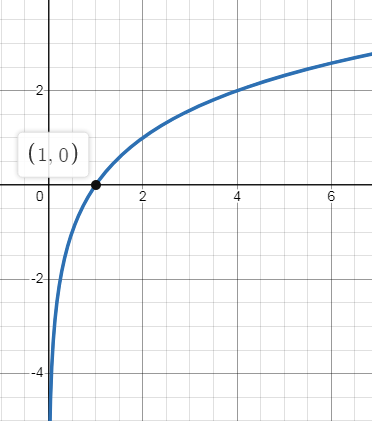
Hence, f(x) = log2x graph cut x-axis at (1, 0).
Problem 2 :
f(x) = log4x
Solution:
Finding points :
f(x) = log4x
If x = 2, f(2) = log42
f(2) = 0.5
If x = 4, f(4) = log44
f(4) = 1
If x = 8, f(8) = log48
f(8) = 1.5
So, the points are (2, 0.5) (4,1) and (8, 1.5).
Finding x and y-intercepts :
|
x-intercept : Put y = 0 0 = log4x 40 = x x = 1 |
y-intercept : Put x = 0 y = log40 There is no y-intercept. |
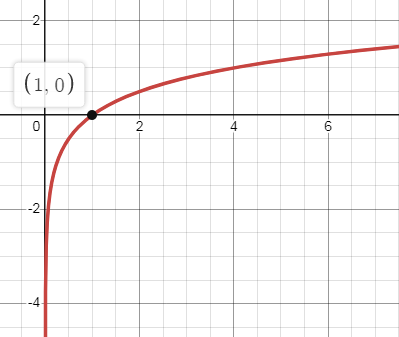
Hence, f(x) = log4x graph cut x-axis at (1, 0).
Problem 3 :
f(x) = log4(x - 3)
Solution:
Finding points :
f(x) = log4(x - 3)
If x = 4, f(4) = log4(4 - 3)
= log41
f(4) = 0
If x = 5, f(5) = log4(5 - 3)
= log4(2)
f(5) = 0.5
If x = 7, f(7) = log4(7 - 3)
= log4(4)
f(7) = 1
So, the points are (4, 0) (5, 0.5) and (7, 1).
Finding x and y -intercepts :
|
x-intercept : Put y = 0 0 = log4(x - 3) 40 = x - 3 x - 3 = 1 x = 4 |
y-intercept : Put x = 0 y = log4(0 - 3) y = log4(-3) There is no y-intercept. |
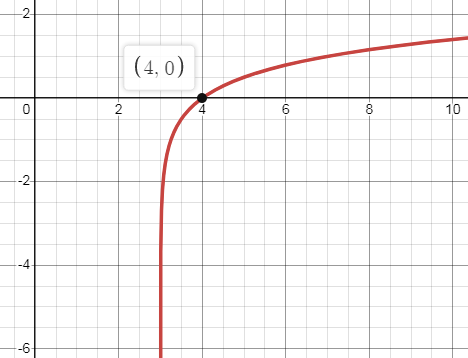
Hence, f(x) = log4(x - 3) graph cut x-axis at (4, 0).
Problem 4 :
f(x) = log2(x + 2)
Solution:
f(x) = log2(x + 2)
Finding points :
If x = -1, f(-1) = log2(-1 + 2)
= log2(1)
f(-1) = 0
If x = 2, f(2) = log2(2 + 2)
= log2(4)
f(2) = 2
If x = 6, f(6) = log2(6 + 2)
= log2(8)
f(8) = 3
So, the points are (-1, 0) (2, 2) and (8, 3).
Finding x and y-intercepts :
|
x-intercept : Put y = 0 0 = log2(x + 2) 20 = x + 2 x + 2 = 1 x = -1 (-1, 0) |
y-intercept : Put x = 0 y = log2(0 + 2) y = log22 y = 1 (0, 1) |
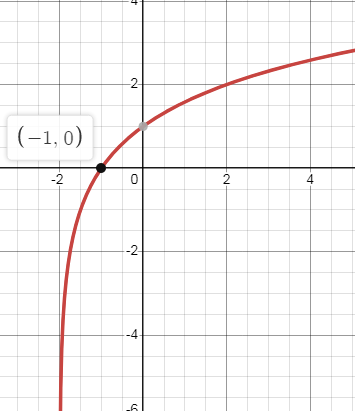
Problem 5 :
f(x) = log3(x + 2)
Solution:
f(x) = log3(x + 2)
Finding points :
If x = 1, f(1) = log3(1 + 2)
= log3(3)
f(1) = 1
If x = 2, f(2) = log3(2 + 2)
= log3(4)
f(2) = 1.2
If x = 3, f(3) = log3(3 + 2)
= log3(5)
f(3) = 1.5
So, the points are (1, 1) (2, 1.2) and (3, 1.5).
Finding x and y-intercepts :
|
x-intercept : Put y = 0 0 = log3(x + 2) 30 = x + 2 x + 2 = 1 x = -1 (-1, 0) |
y-intercept : Put x = 0 y = log3(0 + 2) y = log32 Using change base rule : y = log 2 / log 3 y = 0.6 |
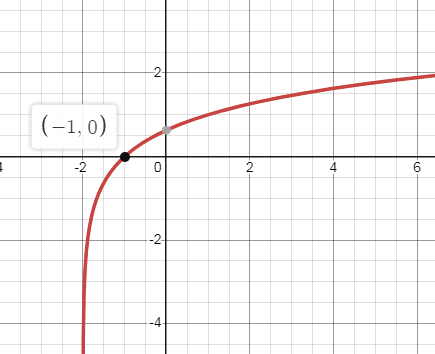
Problem 6 :
f(x) = log5(x - 3) + 2
Solution:
f(x) = log5(x - 3) + 2
Finding points :
If x = 4, f(4) = log5(4 - 3) + 2
= log5(1) + 2
f(4) = 2
If x = 8, f(8) = log5(8 - 3) + 2
= log5(5) + 2
f(8) = 3
If x = 10, f(10) = log5(10 - 3) + 2
= log5(7) + 2
f(10) = 3.2
So, the points are (4, 2) (8, 3) and (10, 3.2)
|
x-intercept : Put y = 0 0 = log5(x - 3) + 2 -2 = log5(x - 3) x - 3 = 5-2 x - 3 = 1/25 x = (1/25) + 3 x = 3.04 |
y-intercept : Put x = 0 y = log5(0 - 3) + 2 there is no y-intercept. |
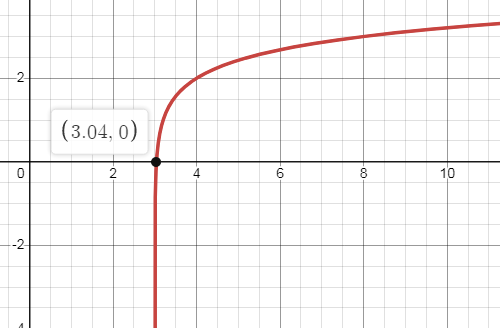
Subscribe to our ▶️ YouTube channel 🔴 for the latest videos, updates, and tips.
Recent Articles
-
Finding Range of Values Inequality Problems
May 21, 24 08:51 PM
Finding Range of Values Inequality Problems -
Solving Two Step Inequality Word Problems
May 21, 24 08:51 AM
Solving Two Step Inequality Word Problems -
Exponential Function Context and Data Modeling
May 20, 24 10:45 PM
Exponential Function Context and Data Modeling